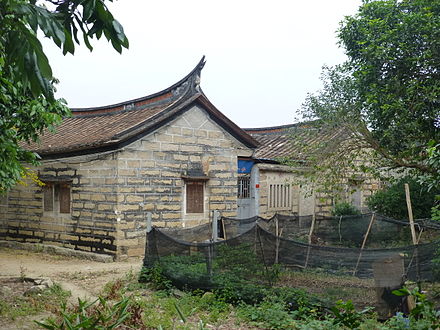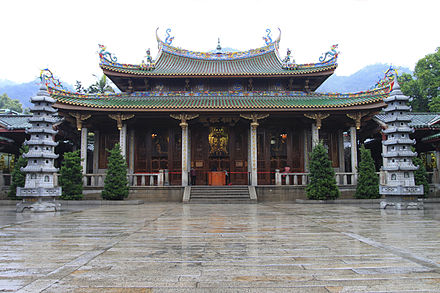South Fujian
South Fujian
South Fujian (闽南 mǐnnán) is a populous region in Fujian Province that has been doing foreign trade for centuries. It is the ancestral home for many overseas Chinese.
Although the city of Putian is not traditionally considered to be part of South Fujian due to the fact that a different dialect is spoken there, as it has more cultural similarity with South Fujian than East Fujian, we group it as part of South Fujian here on Wikivoyage.
Cities
- Putian, between Quanzhou and Fuzhou, birthplace of the popular sea goddess Mazu
- Quanzhou was historically the great port of the region. The prefecture includes other towns:
- Xiamen, booming Special Economic Zone and main economic center of the region, with its suburbs:
- Zhangzhou, inland from Xiamen
- Liu'ao, a windswept peninsula with beaches and interesting stone formations
Other destinations
- Gulangyu , an island in Xiamen that had the consulates and merchants' homes in the era of tea clippers, and is now a major tourist area and a UNESCO World Heritage Site.
Understand

The region has also been a major source of immigrants. In particular, many overseas Chinese in Southeast Asia and most Taiwan are descended from people from this region.
The stone craft


- Houses. In the northern part of the region, a traditional stone building would have a flat roof build of the same stone blocks as the walls. You can see still see many such buildings in, for example, Hui'an County, especially within the walled city of Chongwu. In the southern part of the region (e.g. Zhangpu County), a traditional house is more likely to have an ornate gabled roof covered with tiles; the walls may be completely built of stone, or have the lower part build of stone combined with adobe above a certain point.
- Bridges. An ancient trade route run all along Fujian's coast; as early as during the Song Dynasty, a number of magnificent bridges have been built at the points where the road crosses river's estuary, using supersized stone blocks for the bridge surface. The two well restored bridges worth seeing are the Luoyang Bridge (on the far east side of Quanzhou), and the Anping Bridge (about half-way between Quanzhou and Xiamen). The Shunji Bridge (near downtown Quanzhou) was severely altered during the Nationalist era, and has fallen apart since; some of its pillars still can be seen standing.
- Walled cities. The city walls of the region's major cities, such as Quanzhou, have been demolished in the 20th century, with only a few isolated gate towers have been preserved (or rebuilt) as historic monuments. However, several small isolated wall towns have been preserved and restored. This includes the seaside Chongwu (one of the forts that was built to defend the coast from pirates in the late 14th century) and the two fortified villages (Zhaojiabao and Yi'ancheng) in the inland Huxi She Township (Zhangpu County, south of Zhangzhou)
- Tulou. Unlike the more typical Fujian tulou found in the province's inland counties, a few tulous of the coastal Zhangpu County combine the use of rectangular granite stone blocks with adobe, to an interesting overall visual effect.
- Statues. In some parts of the region (Hui'an County in particular), producing stone statues of all kinds for the national market has become an important industry, and roadsides have become sculptors' showrooms.
Talk
As in most areas of China, Mandarin is very widely spoken and English is not. However, many locals speak Mandarin with a thick local accent, which in Xiamen, Quanzhou and Zhangzhou is very similar to the Taiwanese accent. People from Putian have their own distinctive accents.
Most of the area has Minnan (known as Hokkien in Southeast Asia, and Taiwanese in Taiwan) as the local language, but the region around Putian has its own Puxian dialect (known as Henghua in Southeast Asia), which is part of the same Min family of Chinese dialects but not mutually intelligible with Minnan. In some areas Hakka is also spoken.
Get in
Xiamen has the main airport of the region with connections to all major Chinese cities, quite a few elsewhere in Asia, and even flights to Amsterdam. See Xiamen#By_plane for discussion.
Jinjiang (just across a river from Quanzhou) also has an airport with a number of domestic flights plus some to Hong Kong and Manila.
There is a high-speed rail line running North-South near the coast with stops in the main cities of this area — Putian, Quanzhou, Xiamen, Zhangzhou. It connects north to Fuzhou and on toward Shanghai. Going south, it goes along the coast to Shantou and Shenzhen in Guangdong province.
An additional high-speed line goes inland from Zhangzhou to Longyan. Since 2019, some high-speed trains go on a "Fujian loop" route, from Fuzhou along the coast to Xiamen and Zhangzhou, then inland to Longyan, and then returning to Fuzhou along the inland route, via Sanming and Nanping.
A fair number of conventional overnight trains run from Xiamen via Zhangzhou, Longyan, and Nanchang (Jiangxi Province) to various destinations throughout the country.
Ferries connect Xiamen and Quanzhou with the Taiwan-controlled island of Kinmen.
Get around
The high-speed rail line (see above) is now the most convenient way of getting between the major cities. There are also good highways, and busses that go more-or-less everywhere.
See

The region is known for Minnan-style architecture, which is can be distinguished from the traditional architecture of the rest of China by its "swallowtail roofs" (燕尾脊). Another distinguishing feature of Minnan-style architecture, particularly on temple buildings, is the use of porcelain shards to make colourful, intricate sculptures. This style of architecture is also prevalent in Taiwan, and can also be seen in overseas Chinese communities with large Minnan-speaking populations.
Itineraries
- One possible route in the Ho Chi Minh City to Shanghai overland itinerary goes through this area.
Do
Eat
South Fujian cuisine places a strong emphasis on stews and braised meats, a feature it shares with the cuisine of neighboring Chaoshan. As the majority of Taiwanese are descended from migrants from this region, visitors will find many similarities between the local cuisine and Taiwanese cuisine. Putian has its own distinctive cuisine that differs significantly from that of Xiamen, Quanzhou and Zhangzhou.
This is a coastal area: fishing and fish farming are important industries, and local cuisine emphasizes seafood. Specialties include abalone and eels, which are exported to Japan and to other areas of China in large quantities.
The larger cities, especially Xiamen, also have a range of restaurants serving various sorts of international cuisine.
Drink
The area produces a number of teas. Probably the best-known is an Oolong tea called tie guan yin from Anxi. This has been exported for centuries; it was the tea pitched overboard at the Boston Tea Party.
Stay safe
The general advice at China#Stay_safe applies here.
The Taiwan-controlled island of Kinmen is near Xiamen; both governments consider the area sensitive and keep substantial military forces there, and travellers should not stray into military areas or do anything that might be taken as provocative. This is not nearly as big a deal as it once was — there has not been artillery fire across that strait since the 1970s, and there are now regular ferries between the two sites — but it is still worth considering.
In this area, typhoon are possible at any time May to November, with the highest risk in July and August.
Go next
Adjacent areas of Fujian are (with main tourist attractions shown in brackets):
- Northern Coast (Fujian) (Fuzhou, provincial capital and historic city)
- Inland Fujian (Mount Wuyi and Hakka Tulou, both on the UNESCO World Heritage List)
- Kinmen (by ferry from Xiamen), then fly to Taiwan (short inexpensive flight)
It is also easy to head south into Guangdong province; Chaozhou and Shantou are nearby cities. The high-speed train is the fastest and most convenient way to go, but there is also good bus service.
